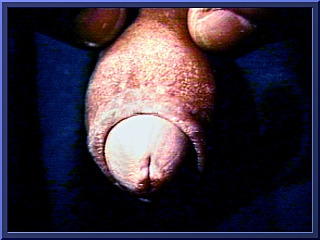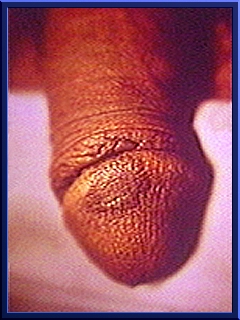
Balanitis, Posthitis and BXO
Diseases of the Uncircumcised Male
UTC
Balanitis
This is a skin condition causing inflammation of the glans penis. Very rarely it can occur in females, affecting the clitoris. It has been shown that uncircumcised males have a higher incidence of penile inflammatory disorders and that 5-10% of all uncircumcised boys eventually undergo circumcision because of the complications of balanitis. Careful hygiene and cleansing of uncircumcised boys may reduce this infection and its complications, thought to be caused by the accumulation of smegma. Prophylactic circumcision completely eliminates such problems before they occur and therapeutic circumcision is an effective cure.
[Alternative name: Balanoposthitis.]
Posthitis
A corresponding inflammation of the foreskin, not necessarily just the inner foreskin - both mucous and non-mucous tissue can be affected. The causes and cures are substantially the same as for Balanitis.
BXO (Balanitis Xerotica Obliterans)
BXO is an auto-immune form of Balanitis. In common with all auto-immune conditions, it is difficult to treat because the body’s natural defence mechanisms are working against the patient’s best interests. Where BXO is treated by circumcision, a radically tight style will be needed. In other respects the condition is similar to Balanitis, so the remarks below concerning Balanitis are also applicable to BXO.
More specifically to BXO: In September 2011 a specific routine of follow-ups was proposed by doctors at the Norfolk and Norwich University Hospital, Norwich, UK.
Management of boys with abnormal appearance of meatus at circumcision for balanitis xerotica obliterans. Holbrook C, Tsang T.
Ann R Coll Surg Engl. 2011 Sep;93(6):482-4. Dealing with the long-term consequences of BXO can be distressing for a boy, strengthening the case for prophylactic circumcision done in infancy.
Taking the three conditions together...
Causes
These conditions are usually a result of poor hygiene in uncircumcised men or boys. However, exposure to caustic soaps or failure to properly rinse the soap while bathing may itself result in inflammation. Therefore this approach to prevention or cure, improperly applied, can end up being a contributory cause. Where available, a pH-neutral liquid soap should be used to wash the genitalia.
Prevention
Commencing at the age when the breakdown of childhood adhesions first permits retraction, the foreskin should be retracted daily to adequately clean, rinse and dry the area underneath. Alternatively circumcision completely eliminates the problem, overcoming the traditional reluctance of small boys to wash properly!
Symptoms
- Redness, soreness or swelling of the glans or foreskin,
- Foul-smelling discharge,
- Painful or itchy penis and/or foreskin.
Treatment
Several topical ointments are available that may provide temporary relief. However, males of any age suffering recurrent balanitis should always be circumcised in order to prevent further episodes. In cases where the inflammation is causing problems with urination, an immediate circumcision may be recommended.
Complications
As well as permanent scarring of the glans (illustrated below), chronic inflammation can result in scarring and narrowing of the meatal opening, a problem known as "urethral stricture".
A separate issue is that the inflammation can make it difficult and painful to return the retracted foreskin to its normal position covering the head of the penis. The retracted foreskin may then swell, leading to constriction of the penis and possibly penile injury - in effect a form of disease-induced paraphimosis.
Calling your health care provider
Notify your health care provider if you are experiencing any of the above symptoms.
Photo Examples
This image shows the scarred tissue of an uncircumcised male who has suffered from both balanitis and posthitis. Such scarring often indirectly leads to further infections, the resulting pain associated with retraction of the foreskin causing further neglect of penile hygiene. |
 |
 |
Scarring of the glans can occur. Note the patches of dark cells both on the glans itself and on the retracted foreskin. Their relative position suggests that the raw surfaces may have adhered at some time during the course of the infection; this would have made retraction both difficult and painful. Scarring can equally well be lighter in colour than the surrounding tissue. |
This photo shows the severely scarred and balanitis-infected glans of a teenager in the latter stages of puberty. Circumcision had been recommended after the first balanitis episode but the procedure was not accepted until after the third and most severe episode shown here. |
 |
Recommended reading
 |
Toguchi, Y. & Weisbrod, M. (Ed.). Private parts: A doctor’s guide to the male anatomy. New York : Doubleday. Dr. Yosh Toguchi is an eminent Canadian urologist. His book is a good source of information about all kinds of urinary problems and is entertaining as well. |
Copyright © 1992 - , All Rights Reserved CIRCLIST.


